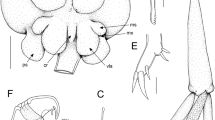Abstract
The cyclopoid copepod family Bradophilidae includes a few species of mesoparasitic copepods infecting flabelligerid polychaetes. It contains two species of Bradophila Levinsen, 1878, the type genus: B. pygmaea Levinsen, 1878 and B. minuta Boxshall, O’Reilly, Sikorski & Summerfield, 2019, both known from North Europe. Two other genera (i.e., Trophoniphila M’Intosh, 1885 and Flabellicola Gravier, 1918) have some affinities with this family including their host preference. Mesoparasitic copepods are highly specialized, morphologically reduced forms. Part of their body (endosoma) is partially lodged in the host body and the other part is external (ectosoma); both parts are connected by an intersomital stalk. Infection by these copepods can be readily detected by the presence of the egg-carrying ectosoma on the host external surface. From the analysis of flabelligerid polychaetes collected in 2012 from the Chukchi Sea, two ovigerous female individuals of a bradophilid copepod were recorded. These specimens were recognized as representative of an undescribed species of Bradophila. The new species, B. susanae n. sp., shows the generic diagnostic characters and differs from its two other known congeners in several respects, including the cuticular ectosomal ornamentation, body proportions, size of the intersomital stalk, position of the genital pore, and shape and arrangement of egg sacs. Also, the new species ectosomal size range (0.440 – 0.450 μm) falls between the size range of its two known congeners. Our finding expands the known host range of bradophilid copepods to include a new flabelligerid host, Bradabyssa nuda (Annenkova-Chlopina) from the Russsian Arctic region.



Similar content being viewed by others
Data availability
Data sharing not applicable to this article as no formal datasets were generated or analysed during the current study.
References
Boxshall, G. A., & Halsey, S. H. (2004). An Introduction to copepod diversity. London, U.K.: The Ray Society.
Boxshall, G.A., O ’Reilly, M., Sikorski, A., & Summerfield, R. (2015). Mesoparasitic copepods (Copepoda: Cyclopoida) associated with polychaete worms in European seas. Zootaxa, 4579(3), 426–436. https://doi.org/10.11646/zootaxa.4579.1.1
Gravier, C. J. (1918). Sur un nouveau copépode (Flabellicola n.g. neapolitana n. sp.) parasite d’un annélide polychète (Flabelligera diplochaitos (Otto)). Comptes Rendus Hebdomadaires des Séances de l’Académie des Sciences, Paris, 166, 502–505. https://www.biodiversitylibrary.org/item/31547#page/512/mode/1up
Ho, J-s. (2001). Why do symbiotic copepods matter? Hydrobiologia, 453, 1–7. https://doi.org/10.1023/A:1013139212227.
Humes, A. G. (1994). How many copepods? Hydrobiologia, 292, 1–7. https://doi.org/10.1007/BF00229916.
Huys, R. (2016). Enigmas from the past: McIntosh (1885) annelidicolous copepods from the voyage of the H. M. S. Challenger. Zootaxa, 4174, 355–385. https://www.biotaxa.org/Zootaxa/article/view/zootaxa.4174.1.22
Levinsen, G.M.R. (1878). Om nogle parasitiske Krebsdyr, der snylte hos Annelider. Videnskabelige Meddelelser fra Dansk Naturhistoriske Forening, Copenhagen 1877-1878, 351–380, fig. 1, pl. 6. http://biodiversitylibrary.org/page/35805578
Marchenkov, A.V. (2002). Bradophilidae fam. nov. —the new family of mesoparasitic copepod collected from the polychaete Brada villosa from the White Sea. Parazitologiya, 36 (6), 514–516. [in Russian with English summary]
M’Intosh, W.C. (1885). Report on the Annelida Polychaeta collected by H.M.S. Challenger during the years 1873–76. Challenger Reports, 12, 1–554. http://19thcenturyscience.org/HMSC/HMSC-Reports/Zool-34/htm/doc.html
Salazar-Vallejo, S. I. (2012). Revision of Ilyphagus Chamberlin, 1919 (Polychaeta, Flabelligeridae). ZooKeys, 190, 1–19.
Salazar-Vallejo, S. I. (2017). Revision of Brada Stimpson, 1853, and Bradabyssa Hartman, 1967 (Annelida, Flabelligeridae). Zootaxa, 4343, 1–98. https://doi.org/10.11646/zootaxa.4343.1.1.
Acknowledgements
The project by which this material was obtained is COMIDA: Chukchi Sea Offshore Monitoring in Drilling Area, funded by the U.S. Bureau of Ocean Energy and Management (BOEM). We deeply appreciate the constructive comments from Dr. G. A. Boxshall (Natural History Museum, London) on the morphology of this species. The polychaete host species was identified by two of us (SIS-V: ECOSUR-Chetumal, LHH: Natural History Museum of Los Angeles County).
Author information
Authors and Affiliations
Corresponding author
Ethics declarations
Conflict of interest
The authors declare that they have no conflict of interest.
Ethical approval
All applicable institutional, national and international guidelines for the care and use of animals were followed.
Additional information
Publisher's Note
Springer Nature remains neutral with regard to jurisdictional claims in published maps and institutional affiliations.
This article was registered in ZooBank as: AB67D4FD-06DF-48EB-A950-58A6A0D711E0.
Rights and permissions
About this article
Cite this article
Suárez-Morales, E., Salazar-Vallejo, S.I. & Harris, L.H. A new Bradophila Marchenkov, 2002 (Copepoda, Cyclopoida, Bradophilidae) parasitic on a flabelligerid polychaete from the Chukchi Sea. Syst Parasitol 98, 111–117 (2021). https://doi.org/10.1007/s11230-021-09964-6
Received:
Accepted:
Published:
Issue Date:
DOI: https://doi.org/10.1007/s11230-021-09964-6




